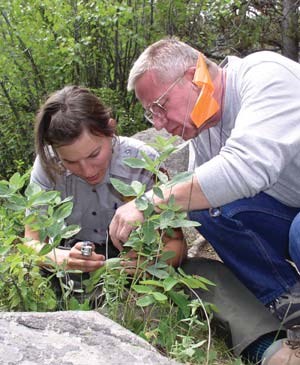Last updated: November 9, 2022
Article
Plant Response to Ozone

The Question: Are high concentrations of ambient ozone damaging plant leaves in Rocky Mountain National Park?
Ozone, an air pollutant and by-product of smog, is formed when nitrogen oxidesand volatile organic compounds react in the atmosphere in the presence of sunlight.
Although mainly an urban air pollutant, it can travel long distances and result in
high concentrations in remote areas, such as national parks. In addition to causing
respiratory problems in humans, ozone is taken up by plants through leaf pores
(stomata) where it causes tissue oxidation, or death of cell tissue, and changes in
biochemical and physiological processes. Reduced growth and reproduction may
result. Measuring the status of ozone bioindicators (ozone-sensitive plants) provides
knowledge about the condition of park resources, thus contributing to regional
air quality policies. Given that Environmental Protection Agency’s ozone standard
for protection of human health is exceeded along the Front Range, the park is an
important site in the evaluation of ozone damage in ecosystems.
The Project: Establish ozone biomonitoring plots and survey plants.
Researchers established an ozone injury assessment program, collected three years of data, and documented the presence of leaf ozone injury. In 2006, staff from the Continental Divide Research Learning Center (CDRLC), park volunteers, and Dr. Robert Kohut of the Boyce Thompson Institute at Cornell University established 32 vegetation plots with two objectives: (1) to assess ozone injury to leaves, and (2) to help implement the “Handbook for Assessment of Foliar Injury on Vegetation in the National Parks.” Dr. Kohut wrote this handbook in cooperation with the National Park Service Air Resources Division. The pilot year began with ozone injury intensive surveys of cut-leaf coneflower (Rudbeckia laciniata) and spreading dogbane (Apocynum androsaemifolium), and less-intensive scoping efforts on quaking aspen(Populus tremuloides) and showy milkweed (Asclepias speciosa). Plant monitoring plots in the park are east of the Continental Divide, mostly along montane streams such as Beaver Meadows, Cow Creek, and the Big Thompson and riparian meadows like Horseshoe and Moraine Parks. The researchers ultimately chose fourteen coneflower plots for continued analysis in 2007 and 2008. If foliar ozone injury was evident, the researchers quantitatively assessed the percentage of injury covering the leaf’s surface.
The Results: Cut-leaf conefl ower leaves exhibited symptoms indicative of ozone injury.
Of 925 coneflower plants surveyed between 2006 and 2008, 250 plants or 27 percent exhibited injury. From those injured plants, 98 percent of leaf injury exhibited on less than 12 percent or less of the leaf’s surface. The researchers noted injury mostly as “black fleck.” Environmental factors, such as moisture and differences in genetics likely resulted in the difference in symptoms observed from eastern to western United States coneflowers. These factors are likely why aspen, dogbane, and milkweed leaves at the park did not exhibit indication of ozone injury.The results of the CDRLC efforts were used to revise Dr. Kohut’s guidebook, and the park will continue to conduct field surveys of ozone injury. Sharing such results with state and federal regulatory agencies will add to the weight of evidence of the detrimental effects of air pollutants on park ecosystems.
